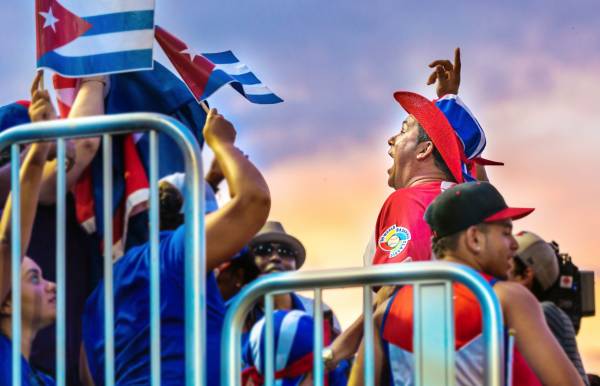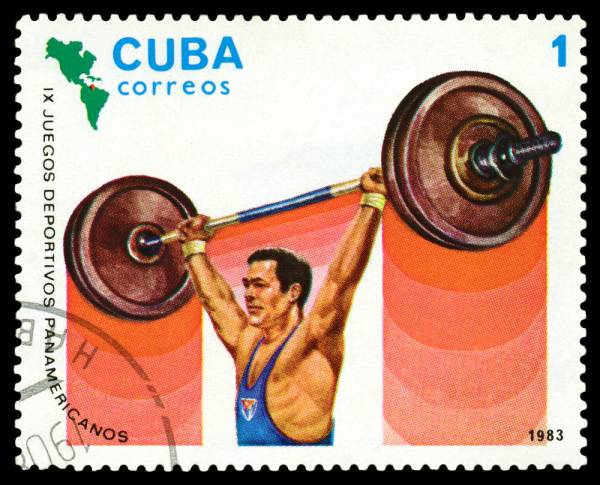Well, the XVII Pan American Games are now history. Held the third year of each Olympiad, these are essentially the Olympics of the Western Hemisphere. The 2015 edition, held in the city of Toronto and environs, was Canada’s third hosting of the event.
With the exception of Canada, the USA, and a few smaller countries, the Pan Ams are mainly a celebration of Hispanic athleticism. Much Spanish is heard at all venues, and Latin American camaraderie is everywhere. Despite all of that, Canada and the USA still dominated the medal podia in Toronto. The USA was first with 265 medals, Canada second with 217, Brazil third with 141, and Cuba finished with 97.
As a recap of the event, let’s look at the medal count and the weightlifting competition in more detail.
Weightlifting at the Games
This Anglosphere dominance did not extend to weightlifting, though. Canada took one silver and one bronze, while the USA had one gold and one silver. The rest went south of the Rio Grande, and competition was keen in all weight categories.
“As some degree of prosperity develops, most countries want to produce their own athletic heroes. Weightlifting may have been targeted by some of them as it is relatively easy to produce a winner in a fairly simple and straightforward sport.”
In the seven women’s divisions, Colombia dominated, taking five golds and one silver with their six-woman team, almost a perfect performance. Venezuela took four medals, one gold and three silvers. The Dominican Republic took one gold and two bronze. Ecuador took one silver and one bronze. Brazil and Mexico finished with two bronze. Chile and Cuba each won single silvers.
The men competed in eight categories. Once again Colombia dominated, but not to the extent they did with their women. They took three gold, two silver, and two bronze. Next was Cuba with two gold, one silver, and one bronze. The rest of the medals were quite evenly distributed. Brazil and the USA each took one gold and one silver. The Dominican Republic one bronze. Ecuador two bronze. Mexico earned one silver, while Canada took a silver and bronze.
Medal Count
The distribution of medals in weightlifting was considerably different from the Games as a whole, and the reasons for this disparity are several. The USA has a large population and that helps to recruit competitors for a wide range of sports. And, of course, it also has the resources to throw at sports (except weightlifting, it seems). A well-developed athletic system in the colleges also certainly helps. This all has to result in higher performances.
Canada’s medal count merits more analysis. As with the USA, Canada has an ability and a willingness to spend money on sports (except weightlifting). And with only about 10% of the US population, Canada still managed to come fairly close to the American medal totals. This is due to a concerted effort by the various sporting bodies to look good on their home turf. It remains to be seen whether Canada will do so well in Lima in 2019. This is also the result of a very long-term effort to participate in more sports than the usual hockey and football. It was long ago discovered that victories in minor sports are a lot easier to achieve than those in a major sport where the competition is too dense.

Competition Organization
As for the competition itself, it was held in the city of Oshawa, about thirty miles east of Toronto. The town is dominated by General Motors’ Canadian plant. The weightlifting competition was held in the GM Centre, the home ice of the Oshawa Generals junior hockey team. The hockey surface was bisected, with one end serving as the competition area and the other as the warm-up room, complete with twelve platforms with new Eleiko barbells on each.
Like all hockey arenas, the seating area was steeply banked offering good views to all. But the competition was sparsely attended for most of the week. Lifting started at 2:00pm and ended about 9:00pm each day. For those who had to be at work, that was not a very convenient time. This could really cut into attendance given that Oshawa’s population is only about 150,000, and Toronto was too far for non-lifting fans to make the commute.
“Many of the stalwarts of the Ontario Weightlifting Association were involved as loaders, venue managers, and a host of other roles necessary for an event of this scope.”
Not only that, but there were forty other events vying for attendees. This is an ongoing problem with major games events. There are so many things happening at once all competing for the same fans, dollars, and time.
The organization of the weightlifting competition was very professional, though. Many of the stalwarts of the Ontario Weightlifting Association were involved as loaders, venue managers, and a host of other roles necessary for an event of this scope. They are to be commended for the success of the weightlifting end of the Games. In particular, I want to mention one Miel McGerrigle. She humbly served as a loader this time, but back in 1999, she was the winner of the 63kg gold.
The Athletes
Now let’s look at the most important participants, the athletes themselves. As something of an old timer going back to the 1967 Games, the thing I notice most is the increased competitiveness of all teams.
Back in those days, the Pan Ams were considered easy medals for the USA and Canada as they had the best athletes by far. Then along came the Cubans, and Canada and the USA had to get used to silvers and bronzes. The Cubans are now not as competitive due to the end of Soviet funding, but many of the other countries mentioned above now have professional coaching and access to training and technical knowledge unavailable before.

More importantly, there is a new will to win shown by many of the emerging nations. As some degree of prosperity develops, most countries want to produce their own athletic heroes. Weightlifting may have been targeted by some of them as it is relatively easy to produce a winner in a fairly simple and straightforward sport. Large investments in infrastructure are not needed and neither are large numbers. If a country can find a sufficiently talented number of people and concentrate on them, then the results will soon show. Compare this to soccer or baseball. If you wanted to go from nothing to dominance in these sports it would take a couple of generations and huge expenditures in infrastructure and athlete development. And still no guarantee of success. But weightlifting is a different story.
Matchups of Note
With regard to the competition, the best matchup was in the 94kg category (full results are available on the IWF website.) Americans Kendrick Farris and Norik Vardanian fought it out for the top two medals, with Farris winning at 366kg compared to Vardanian’s 362kg. Farris looked very strong and sure of himself, and both used the power style of jerk. Cuban Javier Vanega was right behind with 361.
In the women’s 75+ category, one lift brought the crowd to the edge of their seats. This happened when Holley Mangold (USA) asked for 154kg for her final clean and jerk. Up to then, she had been sitting firmly in fifth place out of five, and it appeared her wrist was still bothering her. Her snatches were still well below her previous bests, and she had only made one successful jerk to solidify her fifth-place. But if she were to make this 154 on her final lift – she would take the gold.
She cleaned the weight quite easily, but was not able to jerk it. The crowd was behind her. No doubt many of them remembered her from her Biggest Loser appearances and were surprised to see a familiar face.
The final session of the week was the men’s 105+ category. While the local crowd had high hopes for Canada’s 39-year-old George Kobaladze, it was Fernando Reis of Brazil who stole the show, ending with an easy 235kg jerk and breaking all his own records in the process.
High Quality, Low Exposure
One unfortunate thing about the Pan-American Games that has existed since their founding in 1951 is the fact they are overshadowed by the Olympics. They remain nearly unknown outside sporting circles. This is too bad because the quality of competition is high and the competition often foreshadows the following year’s Olympic results. Unfortunately, the media nearly ignores these games unless they are on home turf.
Due to the fantastic outcomes of these 2015 Games, let’s hope the same is not true for Lima, Peru in 2019.
More Like This:
- The Pan American Youth Weightlifting Championships
- Athlete Journal: Holley Mangold, Entry 1
- What to Do (and Not Do) on Competition Day
- New on Breaking Muscle Today
Photos courtesy of Shutterstock.






